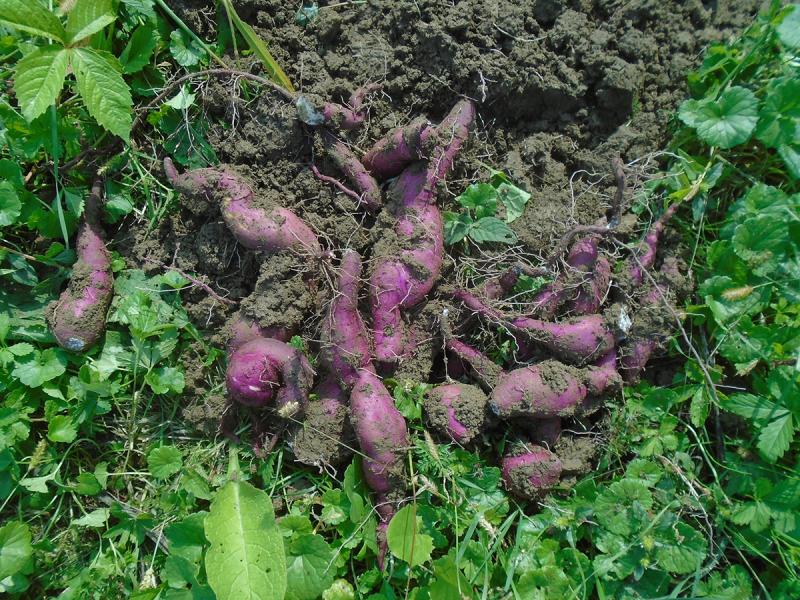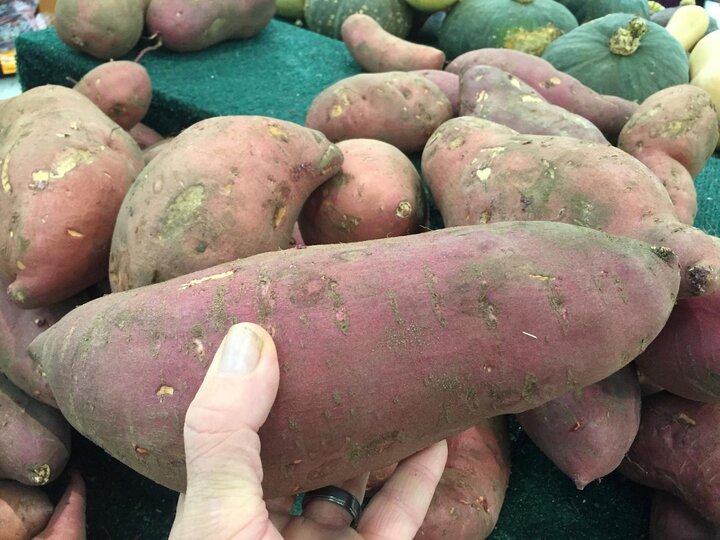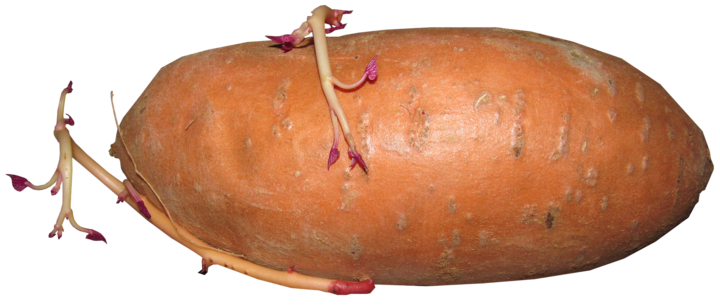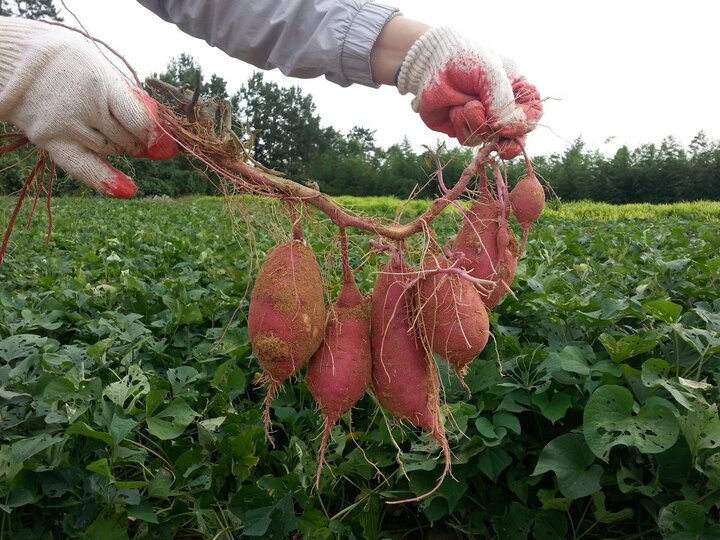Sarah Browning, Nebraska Extension Educator

Purple skin sweet potatoes. Images from Pixabay.
Yam or Sweet Potato?
Sweet potato, botanically named Ipomoeas batatas, is a member of the morning glory family and native to Central and South America. In the United States, the terms yam and sweet potato are often used interchangeably but true yams are a completely different plant. True yams are in the Dioscorea genus and native to West Africa and Asia. Their flesh ranges in color from white or yellow to purple or pink when mature; they have a rough scaly outer skin and are starchier and drier than sweet potatoes. True yams are relatively uncommon in the U.S.
The term “yam” began being used in the U.S. by the Louisiana sweet potato industry in 1937 as part of a national marketing campaign to differentiate their moist, orange-fleshed sweet potatoes from those grown on the east coast at that time, which had white flesh and a drier texture. White-fleshed cultivars of sweet potatoes are uncommon in the U.S. today. The term “yam” is an English version of the African term “nyami”, which refers to true yams.

Growing Sweet Potatoes
If you’ve never tried growing sweet potatoes in your garden, it’s definitely worth a try. Since they are tropical plants, sweet potatoes like hot weather and do little in the garden until soil warms to 65°F or higher. They will be injured by any amount of cold weather, so monitor your soil temperature and wait to plant until the soil has warmed. Check your local soil temperature in spring or measure it yourself at a 4” depth using a soil thermometer.
Sweet potatoes also need a long growing season, 100-110 days depending on the cultivar you choose. Some common cultivars are listed below. Plants sprawl out more than Irish potatoes, so if your garden is small look for bush types with more compact growing habits. Once established, sweet potatoes are tolerant of hot, dry weather and have few pest problems.
- Beauregard -100 days to harvest, light purple skin, dark orange flesh, extremely high yielder from Louisiana State University
- Bush Porto Rico -110 days, compact vines, copper skin, orange flesh, heavy yield
- Centennial -100 days, orange skin and flesh, good keeper, resistant to internal cork and wilt
- Georgia Jet -100 days, red skin, orange flesh, somewhat cold tolerant
- Jewel -100 days, orange flesh, good yield, excellent keeper
Planting
Sweet potatoes are grown from plants or slips. Purchase bunches of slips from your local nursery in spring or purchase them from a mail order nursery. Check with the companies below.

It's also easy to grow your own slips, Place a sweet potato root on its side in a container and place moist sand around it. About 3/4 of the tuber should be buried in the sand. Place the container in a warm location and give it about six weeks for the root to develop new growth shoots. Each tuber can easily produce 4-5 slips. Keep the sand moist during this time, but don’t allow it to become waterlogged. Pull shoots from the root or cut them off about 1” above the soil line when they reach about 6-8" tall. Cutting the shoots prevents rot diseases from entering the root while it continues to produce additional shoots. Slips do not need roots before they are planted in the garden. They will quickly develop roots of their own once planted in warm, moist soil. After harvesting the slips, loosely tie them in bundles and place the cut ends in water until they can be planted.
A 10-foot row of healthy sweet potato plants, which would include 12 plants if planted on a 12" spacing, will produce approximately 6 to 15 pounds of tubers. This gives you some idea of how many plants or slips will be needed for your family.
Planting in ridges of loose soil 8-12” high allows the soil to warm faster in spring, improves drainage, and gives the roots room to expand. Ridging also makes harvesting easier when digging. Space rows at least 3 feet apart, and plants 12” apart in the rows. If you only plant a few sweet potatoes, creating mounded hills of soil works well too. Vines may spread 6-8 feet wide.
Sweet potatoes grow best in moderately fertile soils. Avoid excessively rich or highly fertilized soil. Plants grown on light sandy soil will benefit from 1 to 2 sidedress applications of nitrogen during the growing season. Apply phosphorus and potassium only if a deficiency is indicated by a soil test.
Hoe as needed early in the season to control weed growth. Dense vine growth will suppress most weeds later in the season.
Plants are well adapted to hot, dry weather, but a good deep soaking in August during dry periods will improve your harvest.

Harvest
Harvest as soon as the roots reach eating size and before frost. If vines do get frosted, dig them immediately. Decay in dead vines passes down to the roots and affects their storage potential. If immediate digging isn’t possible when frost is predicted, cut away the vines and throw loose soil over the rows to protect roots from the cold. Soil or storage temperatures below 55°F can cause chilling injury.
Ideally, the roots are cured at 85°F and 90-95% relative humidity for 4-8 days after harvest and before storing. But keep in mind that if air temperatures are lower than 85°F, it will take longer for cuts on the roots to heal. After curing, store your sweet potatoes at 55-59°F and 85-90% relative humidity.
Next year, you could be enjoying sweet potatoes from your own garden.
Images
- Feature image - purple skin sweet potato.
- Sweet potatoes easily develop new growing shoots, sometimes even while in storage. You can make use of this characteristic to grow your own sweet potato slips.
- Sweet potatoes are one of the most popular vegetables during the holidays and can easily be grown in a home garden.